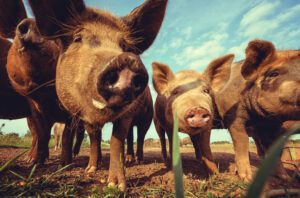 “The creatures outside looked from pig to man, and from man to pig, and from pig to man again: but already it was impossible to say which was which.”
“The creatures outside looked from pig to man, and from man to pig, and from pig to man again: but already it was impossible to say which was which.”
That’s George Orwell in Animal Farm, making a political, allegorical, point. But he also could have been talking about biology.
Humans and pigs share a lot of similarities when it comes to anatomy and physiology. Pigs’ organ systems are 80-90 percent similar to those of humans, veterinary researcher Dr. Michael Swindle told FOX News in 2014.
“They are what’s known as a translational research model, so if [something] works in the pig, then it has a high possibility of working in a human,” Swindle said.
That’s why the news last year that researchers had eliminated PERVs – which stands for porcine endogenous retroviruses – in some pig kidney cell DNA was so important.
Pig tissue and valves have been transplanted into humans, but not entire organs. That’s because the PERVs which exist in the pig organ could be harmful to a human host.
A team lead at eGenesis, a Boston life-sciences company, announced last October it had edited the pig genome in 62 places, reducing the chance for infection.
In the wake of this news, researchers are now anticipating human trials with solid organs such as kidneys from genetically modified pigs to happen in the next few years.
According to the science journal Nature, a number of advances have occurred in the field:
- A genetically-modified pig kidney supported a baboon’s life for six months, while a genetically-modified pig heart survived in a baboon’s abdomen for more than two years.
- Pig livers could be engineered to produce their own antibodies against primate immune cells.
- United Therapeutics, a Maryland company, is hoping to produce 1,000 pig lungs per year on a farm in North Carolina.
- Last April, China approved pig corneas for marketing.
- Phase III clinical trials of insulin-producing islet cells have begun.
United Therapeutics has spent $100 million to get its pigs ready, and wants the lungs ready for clinical trials within the next four years.
But some researchers say that timeline doesn’t take into account regulatory concerns about safety.
“I think we’re getting closer, in terms of science,” transplant surgeon Jeremy Chapman of the University of Sydney’s Westmead Hospital in Australia told Nature. “But I’m not yet convinced we’ve surpassed all the critical issues that are ahead of us. Xenotransplantation has had a long enduring reality that every time we knock down a barrier, there’s another one just a few steps on.”
And the FDA told Nature it was still concerned about diseases being caused by PERVs. It suggests that until animal-to-human transplants are shown to be extremely safe, they should be limited to patients with life-threatening illnesses and no other options.
As these studies continue, Animal Biotech will play the role it has for more than 25 years: supporting the biomedical community by providing researchers with post mortem porcine tissues, organs, and glands. Contact us today to learn how we can assist you.


